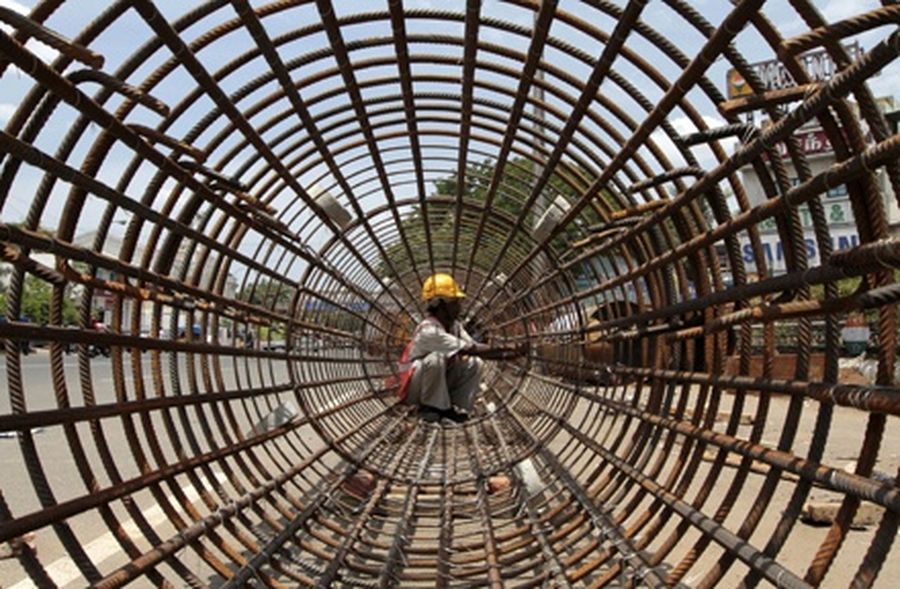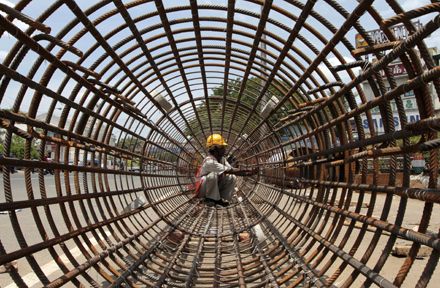India has unveiled a range of policy measures in a bid to restore confidence in its economy and close its infrastructure deficit. Investors, however, are waiting to see whether or not the country’s bureaucracy can follow through on its promises.

Source: Reuters/Babu
A worker wires steel rebars at a construction site of a metro station in the southern Indian city of Chennai.
Attendees to this year’s Asian Development Bank annual meetings will not need to look far to see the extent of the challenges facing Asia. India, with more than a quarter of Asia’s population, has consistently posted rapid economic growth, improved living standards across the board and lifted millions out of poverty. Despite that progress, however, many millions more live without access to clean water, electricity or basic sanitation. Growth is also slowing, and the country needs to tread carefully to prevent development from slipping backwards.
The country’s inadequate infrastructure has become a defining feature, along with its lumbering political structure. Inflation and fiscal problems remain unresolved, and confidence in the country’s potential is waning.
At the same time, India plans to spend more on infrastructure, with US$1trn earmarked for the sector in 2012–17, up from US$500bn in the previous five years. The government’s five-year plan calls for as much as 47% of the US$1trn total to come from the private sector.
Mobilising infrastructure investment is a challenge that India shares with many other Asian nations. Like Asia as a whole, India boasts a deep domestic investor base, but has struggled to channel its own savings towards its infrastructure shortage.
“If there is any message for India, it is that the focus on infrastructure must continue,” said Rajat Nag, ADB managing director general.
India’s economy grew just 5% in the fiscal year to March 31 2013, down from 6.2% the previous year and its lowest growth rate in a decade, according to the ADB.
An exodus of foreign capital has weakened its currency, but exports still contracted in fiscal 2012, while domestic investment and consumption also weakened. Corruption scandals, unexpected tax demands and failed investments have plagued the power and telecom sectors.
Ministers have announced a series of policy measures aimed at restoring confidence, but the business community remains sceptical about their impact.
“There have been a number of changes to policy and most are for the better. There is a willingness to address the issues,” said Jaideep Khanna, country head and CEO for India at Barclays. “What we are witnessing is very slow progress, and the mood among investors remains sceptical.”
The ADB is predicting a modest rebound in growth to 6.0% in fiscal 2013 and 6.5% in 2014, but highlights the challenge in stimulating domestic investment at a time when fewer new projects are being announced and more are being shelved.
“The policies are good and robust,” said Nag. “The challenge is implementation.”
Reforms promised in 2012 include a fast-track process for priority infrastructure projects, as well as tax relief for infrastructure financings – both domestic and offshore – and looser restrictions on foreign investment in industries from aviation to retail.
As so often in the past, India’s slow-moving bureaucracy has created doubts about the execution of these pledges. A cut in withholding tax paid on overseas interest payments, for instance, was first promised in the Union budget in February 2012, raising hopes that Indian infrastructure companies would be able to access cheaper, long-term money in the global capital markets.
Bankers and potential issuers had to wait until September for the tax cut, from 20% to 5%, to be finally signed into law. More than eight months later, however, confusion still reigns over whether or not the reduced tax rate can be applied, due to conflicting sections of the country’s tax code. Calls for the government to issue a clarification in the 2013 budget statement went unheeded, and more companies missed out on the chance to lock in US dollar funding at extraordinarily low interest rates.
“The policies are good and robust. The challenge is implementation”
Similarly, a Rs535bn quota of tax-free bond sales went underutilised after an archaic piece of company law prevented local companies from investing in the notes.
“There is still some scepticism within the Indian business community over the government’s ability to implement these policies,” said Khanna.
After a slump in the rupee in early 2012, and a well-publicised warning from Standard & Poor’s that India could lose its investment-grade sovereign rating, the government has taken numerous steps to restore confidence in the international community. Foreign investors have greater access to rupee bonds under an expanded quota system, and an offering of inflation-linked bonds is due before the end of June.
Infrastructure debt funds, aimed at deepening the local capital markets and allowing India’s banks to reduce their exposure to the sector, have attracted some interest – both at home and abroad. However, only one such fund has been launched after more than a year in the making, and it has yet to make its first investment.
The IDF initiative promises to give domestic lenders an opportunity to recycle their capital with the refinancing of projects in the bond markets. The IDF investors will provide cheap, long-term financing to be repaid through cash flows from the project.
ICICI Bank, which has a 31% stake in the fund, dubbed Infradebt, announced the launch in late February. Bank of Baroda is contributing 30% of the Rs3bn (US$55m) equity, while Citigroup is stumping up 29% and Life Insurance Corp of India 10%. It will invest in public-private partnerships that have been in operation for at least a year, and plans to issue bonds to complete its own financing structure.
“The government is not lacking ideas,” said Khanna. “The problem is that very few projects currently generate sufficient cash flow.”
The move to promote the capital markets as a source of infrastructure funding is gathering pace, with India’s domestic lenders facing greater pressure to fill a gap that retreating foreign banks created.
“Overseas lending has not, historically, been a key component of Indian infrastructure finance, but the additional liquidity that comes from foreign lenders has allowed the local banks to recycle some capital and invest more,” said Khanna. “Since the global financial crisis, spreads have moved higher and the punitive capital costs and risk of a ratings downgrade mean it has been hard to find any foreign institution willing to invest.”
Encouraging local institutions to support infrastructure development will require a change of mindset in the rupee capital markets, where investors remain extremely conservative and have little appetite for credit risk. Double A ratings are a standard in the local bond market, and long tenors are rare.
The ADB aims to address that through an innovative credit enhancement programme, agreed in September 2012. (See Box.)
“The model India wants is to use the ADB as a catalyst for PPP,” said Nag. “The financing architecture is key. There is a big pool of domestic capital in India, but there is a mismatch on credit and maturity. We want to see companies able to access whatever resources are available.”
For Khanna, any long-term solution will require an improvement in the investment climate, not just the capital markets.
“The challenge for policy makers over the next year to 18 months is to create the right climate for investment. Only then will equity investment come in, which is critical for the overleveraged infrastructure sector. After that recapitalisation, credit can follow.”
To see the digital version of this report, please click here.
